Homework assignments (4,5 credits) in Computational Physics
Homework assignments (4,5 credits) in Computational Physics
Homework assignments (4,5 credits) in Computational Physics
Create successful ePaper yourself
Turn your PDF publications into a flip-book with our unique Google optimized e-Paper software.
<strong>Homework</strong> <strong>assignments</strong> (4,5 <strong>credits</strong>) <strong>in</strong> <strong>Computational</strong><br />
<strong>Physics</strong><br />
Olle Edholm and Mats Wall<strong>in</strong>, Department of Theoretical <strong>Physics</strong>, KTH<br />
December 6, 2007<br />
You are supposed to select ONE of the problems described below. It is important<br />
that the problem is solved <strong>in</strong>dividually, but some collaboration with other students is<br />
accepted. You are welcome to consult the <strong>in</strong>structors of the course and the literature if<br />
help is needed.<br />
The report should be written <strong>in</strong>dividually. The report should be typed on a computer<br />
and sectioned as a professional report, conta<strong>in</strong><strong>in</strong>g title, author, abstract, section headers,<br />
etc. Use spell checks. Computer produced plots should be <strong>in</strong>cluded with figure number<strong>in</strong>g<br />
and captions.<br />
You are supposed to write and run your own computer program. The programm<strong>in</strong>g<br />
language is supposed to be an efficient language, like fortran, C, C++, ... (but preferably<br />
not Maple, Matlab, or Mathematica). Include a short list<strong>in</strong>g of relevant parts of the<br />
computer code <strong>in</strong> the report.<br />
Some problems are easier and some are harder. You do not have to follow the <strong>in</strong>structions<br />
exactly, and it is allowed to skip or add steps if you want. For help and more<br />
<strong>in</strong>formation on the problem, please ask the <strong>in</strong>structors.<br />
Deadl<strong>in</strong>e for the reports extended until: Jan. 10. 2008<br />
1 Molecular dynamics of a hard sphere fluid<br />
Instructor: Olle Edholm<br />
Write the program. This has to be written differently than a program us<strong>in</strong>g cont<strong>in</strong>uous<br />
forces. This requires some fairly elaborate programm<strong>in</strong>g. In the hard sphere fluid the<br />
force is zero all the time except when two spheres collide. Then the force is <strong>in</strong>f<strong>in</strong>ite.<br />
Therefore, you should start by mak<strong>in</strong>g a table of the time for the next collision of each<br />
particle and the number of the particle it will collide with. Then you just assume that<br />
all particles will move along straight l<strong>in</strong>es (tak<strong>in</strong>g the periodic boundaries <strong>in</strong>to account)<br />
with their given (random) <strong>in</strong>itial velocities. Then you pick the shortest time <strong>in</strong> this table.<br />
Now, you subtract this time from all other times <strong>in</strong> the table. If it was particle i and j<br />
that collided, you have to calculate their new velocities from the rules of elastic collisions.<br />
It might be useful to consult a textbook <strong>in</strong> classical mechanics for this problem. Further<br />
you have to calculate the next time they will collide with all other particles and update<br />
the table accord<strong>in</strong>gly. F<strong>in</strong>ally you may iterate this procedure.<br />
Measure the density as the degree of close pack<strong>in</strong>g η = 4πNR 3 /3V . You may use<br />
dimensionless units (R = 1). The velocities should be random with an average zero. You<br />
1
can, however, use dimensionless velocities. Chose them for <strong>in</strong>stance <strong>in</strong> such a way that<br />
you will get the mean square velocity equal to 1. Use the program to calculate the pair<br />
correlation function of the hard sphere fluid at a couple of densities. You should get a<br />
pair correlation function that is zero for r less than 2 and has a couple of oscillations<br />
with a period <strong>in</strong> r that is of the order 2. Reasonable degrees of close pack<strong>in</strong>g should be<br />
<strong>in</strong> the <strong>in</strong>terval 0.1 up to maybe 0.5. (References: Allen and Tildesley, p. 102-108 or B.J.<br />
Berne, Statistical Mechanics part B p 1-40)<br />
2 Write a Monte Carlo program to simulate a LJfluid<br />
(argon)<br />
Instructor: Olle Edholm<br />
Use periodic boundary conditions and make the simulations at fixed N, V and T .<br />
Calculate energy and pressure. Use the same parameters, densities and temperatures as<br />
you used <strong>in</strong> the MD lab on argon. Check that you get similar energy and pressure as <strong>in</strong><br />
the MD-simulations. Don’t forget the k<strong>in</strong>etic part of energy and pressure. Experiment<br />
with different ways of sampl<strong>in</strong>g obey<strong>in</strong>g detailed balance (different maximum step lengths<br />
<strong>in</strong> the moves and mov<strong>in</strong>g one or several particles at the same time) and monitor how this<br />
affects the acceptance ratio. Start from a system equilibrated at wrong temperature and<br />
see how the choice of the moves affect convergence. Is there some correlation between<br />
acceptance ratio and rate of convergence (Reference: Allen and Tildesley, chapter 4.4)<br />
3 Temperature control <strong>in</strong> MD<br />
Instructor: Olle Edholm<br />
Program the Nose’-Hoover thermostat and compare it to the simple velocity scal<strong>in</strong>g<br />
with a time constant used <strong>in</strong> the argon computer lab. The equations of motion can be<br />
written on the follow<strong>in</strong>g form for both thermostats:<br />
d<br />
dt ¯p i = −∇ i U − ξ ¯p i<br />
i = 1, ....N<br />
The difference is <strong>in</strong> the equation of motion for the heat bath degree of freedom (ξ) which<br />
<strong>in</strong> the Berendsen scal<strong>in</strong>g method can be written:<br />
while it becomes:<br />
ξ = 1<br />
2τ [ 1<br />
3Nmk B T<br />
∑<br />
¯p 2 i − 1]<br />
i<br />
d<br />
dt ξ = 1 ∑<br />
ω2 [<br />
¯p 2 i − 1]<br />
3Nmk B T<br />
i<br />
<strong>in</strong> the Nose’-Hoover case. Both methods conta<strong>in</strong> a parameter τ or ω. Check for both<br />
methods, how the values of these parameters affect temperature stability, fluctuations<br />
and the responses of the system to small sudden changes <strong>in</strong> the temperature of the<br />
heat bath. Check also how well the velocities obey a Maxwellian distribution <strong>in</strong> the two<br />
cases. Calculate the heat capacity from the canonical ensemble equation based on energy<br />
fluctuations for both types of simulation. Compare the results with each other, with<br />
2
the heat capacity obta<strong>in</strong>ed from temperature fluctuations <strong>in</strong> a micro canonical (NVE)<br />
simulation and with experimental heat capacities. You may use the MD-program from,<br />
the argon computer lab as a template and make the changes there. (Reference, Frenkel<br />
& Smit p. 125-141.)<br />
4 Monte Carlo studies of simple <strong>in</strong>tegrals<br />
Instructors: Mats Wall<strong>in</strong> or Olle Edholm<br />
S<strong>in</strong>ce this problem is more elementary than the rest, the requirement on the report<br />
is higher <strong>in</strong> order to get grade higher than 3.<br />
Study various simulation methods for the simple test <strong>in</strong>tegral<br />
∫ ∞<br />
0<br />
∫ ∞<br />
0<br />
dx xe −x2<br />
dx e −x2<br />
Evaluate <strong>in</strong> four different ways: (1) Us<strong>in</strong>g a Metropolis method. (2) Simple Monte Carlo.<br />
(3) Simpson’s rule. (4) Exactly us<strong>in</strong>g analytic <strong>in</strong>tegration. In (1), experiment with the<br />
maximum step size δ. Beg<strong>in</strong> with δ = 1, then compare with δ = 0.1 and δ = 10.<br />
Study the statistical error <strong>in</strong> the MC methods by tak<strong>in</strong>g the average RMS error (error<br />
=result from (1) m<strong>in</strong>us result from (4)) as a function of the number of terms N (for<br />
example, N = 10, 100, 1000, 10000, ...) <strong>in</strong> the MC calculation. Is this a good measure of<br />
the statistical error <strong>in</strong> (1) and <strong>in</strong> (2) Why or why not Study the correlation time τ <strong>in</strong><br />
(1). In (1), it is necessary to repeat the calculation many times, and calculate the RMS<br />
errors from the results of these <strong>in</strong>dependent runs. Plot the RMS error vs. N <strong>in</strong> log-log<br />
plots. Compare the cpu times for (1)-(3) to reach a certa<strong>in</strong> error level. Also study the<br />
the more complicated oscillatory <strong>in</strong>tegral<br />
∫ ∞<br />
−∞<br />
dx s<strong>in</strong> 2 1 x<br />
5 Effects of frustration <strong>in</strong> the two-dimensional Is<strong>in</strong>g<br />
model on a triangular lattice<br />
Instructor: Mats Wall<strong>in</strong><br />
The two-dimensional Is<strong>in</strong>g model can also be def<strong>in</strong>ed on a triangular lattice, and then<br />
each sp<strong>in</strong> has six nearest neighbors. Study it <strong>in</strong> zero applied field. Simply add a coupl<strong>in</strong>g<br />
along one of the diagonals of each elementary square <strong>in</strong> the Monte Carlo code for the<br />
square lattice from the Is<strong>in</strong>g lab.<br />
Compute the B<strong>in</strong>der ratio and determ<strong>in</strong>e T c from it. Expla<strong>in</strong> why it is bigger or<br />
smaller than the value for the square lattice. Do a f<strong>in</strong>ite size scal<strong>in</strong>g analysis of g to<br />
determ<strong>in</strong>e ν. Is it smaller or bigger than for a square lattice Try to expla<strong>in</strong>!<br />
F<strong>in</strong>ally, change the sign of the coupl<strong>in</strong>g constant J to J = −1, which corresponds to an<br />
antiferromagnet. On a square lattice this can be transformed back to the ferromagnetic<br />
case J = +1 by flipp<strong>in</strong>g every other sp<strong>in</strong> <strong>in</strong> a checker board pattern. But for J = −1 a<br />
new phenomenon enters called frustration: no matter how the sp<strong>in</strong>s around an elementary<br />
triangular plaquette orient themselves, one of the three <strong>in</strong>teractions will be <strong>in</strong> the excited<br />
state. Do the same simulations as for the ferromagnetic case above.<br />
3
6 Monte Carlo simulation of the three dimensional<br />
classical xy-model<br />
Instructor: Mats Wall<strong>in</strong><br />
Repeat the same tasks as <strong>in</strong> the Is<strong>in</strong>g lab for the three dimensional classical xy-model.<br />
The energy is def<strong>in</strong>ed by:<br />
H = −J ∑<br />
cos(θ i − θ j )<br />
<br />
where θ i ∈ [0, 2π] is phase angle at lattice po<strong>in</strong>t i, and ∑ denotes nearest neighbor<br />
summation on a lattice with L 3 = N lattice po<strong>in</strong>ts. The temperature T enters through<br />
the partition function Z = Tr θi exp −H/T . Here Tr means that each θ i shall be <strong>in</strong>tegrated<br />
from 0 to 2π.<br />
Def<strong>in</strong>e the B<strong>in</strong>der ratio as<br />
R = 〈m4 〉<br />
〈m 2 〉 2<br />
where m is the absolute value of the volume average of the complex order parameter<br />
field, given by<br />
1 ∑<br />
m =<br />
e iθ j<br />
∣N<br />
∣<br />
Study the B<strong>in</strong>der ratio and the other thermodynamic quantities. Comment on the limits<br />
of the B<strong>in</strong>der ratio for low and high T . Determ<strong>in</strong>e the critical temperature and critical<br />
exponents. Study the equilibrium time near T c .<br />
(H<strong>in</strong>t: Do not bother to def<strong>in</strong>e a f<strong>in</strong>ite step length, ∆θ, for the maximum update<br />
of the phase angle. Instead simply draw the updated phase angle uniformly <strong>in</strong> [0, 2π].<br />
There is actually no ga<strong>in</strong> <strong>in</strong> the amount of uncorrelated data per CPU time <strong>in</strong> us<strong>in</strong>g a<br />
f<strong>in</strong>ite step length, even if the acceptance rate can be made larger. On the other hand,<br />
restrict<strong>in</strong>g θ to tak<strong>in</strong>g only, say, 1000 discrete values <strong>in</strong> [0, 2π], and us<strong>in</strong>g look-up tables<br />
for everyth<strong>in</strong>g, will speed up the code.)<br />
7 Monte Carlo simulation of the three dimensional<br />
classical Heisenberg model<br />
Instructor: Mats Wall<strong>in</strong><br />
Same as problem 3, but with xy sp<strong>in</strong>s replaced by 3-component classical Heisenberg<br />
sp<strong>in</strong>s. The Hamiltonian is then given by<br />
j<br />
H = −J ∑<br />
<br />
⃗S i · ⃗S j<br />
where ⃗ S i is a vector “sp<strong>in</strong>” lattice po<strong>in</strong>t i, and ∑ denote nearest neighbor summation.<br />
The Heisenberg sp<strong>in</strong>s have three components: S = (S x , S y , S z ). The length of the sp<strong>in</strong><br />
is S 2 = 1, and we can therefore use represented by their spherical polar angles (θ, φ) to<br />
specify the direction. Note that the <strong>in</strong>tegration volume element is s<strong>in</strong> θ dθ dφ, as usual <strong>in</strong><br />
spherical coord<strong>in</strong>ates. Repeat the same steps as <strong>in</strong> Problem 6.<br />
4
8 Self avoid<strong>in</strong>g random walks<br />
Instructors: Olle Edholm and Mats Wall<strong>in</strong><br />
An <strong>in</strong>terest<strong>in</strong>g and extensively studied problem <strong>in</strong> polymer physics is to model a<br />
polymer cha<strong>in</strong> <strong>in</strong> a good solvent as a self avoid<strong>in</strong>g random walk, where each step taken by<br />
the walker represents one segment of the polymer (one monomer). Crudely speak<strong>in</strong>g, the<br />
dist<strong>in</strong>ction between “good” and “poor” solvent is that <strong>in</strong> a good solvent the <strong>in</strong>teractions<br />
between the polymer and the solvent molecules is more important than the long-range<br />
<strong>in</strong>teractions between polymer molecules, and the latter can be ignored. You will study<br />
the average end-to-end distance <strong>in</strong> various spatial dimensions by Monte Carlo simulation<br />
of random walks on simple cubic lattices.<br />
(a) Free random walk. The ord<strong>in</strong>ary “free” random walk can be simulated by<br />
simple sampl<strong>in</strong>g of random steps on a simple “cubic” lattice <strong>in</strong> 1, 2, 3 and 4 dimensions).<br />
Start at the orig<strong>in</strong>. Take one step to any nearest neighbor lattice site at random, and<br />
from there take another step, etc. Calculate the exponent p = 2ν <strong>in</strong> 〈RN〉 2 ∼ N p <strong>in</strong> the<br />
limit of a large number of steps N, where R N is the end-to-end distance of the cha<strong>in</strong><br />
after N steps. It is useful to average the results over many walks, so the program should<br />
do at least 10 4 <strong>in</strong>dependent walks <strong>in</strong> one run. Derive the exact result p = 1 and compare<br />
with the simulation results.<br />
(b) Simple sampl<strong>in</strong>g of SAW. Modify your program to simulate a model of a<br />
polymer as a self avoid<strong>in</strong>g random walk on the lattice. Self avoid<strong>in</strong>g means that the<br />
walk cannot cross its previous path. This can be sampled as follows: Do an ord<strong>in</strong>ary<br />
walk, as <strong>in</strong> (a). Do not use moves that br<strong>in</strong>g the walker back to position occupied at the<br />
previous step, so <strong>in</strong> d dimensions use an equal probability to move <strong>in</strong> 2d − 1 directions.<br />
If the walker reaches a site where it has previously been, the walk term<strong>in</strong>ates. It is thus<br />
necessary to keep track of all the previous locations of the walker. This can be done by<br />
stor<strong>in</strong>g a vector with visited coord<strong>in</strong>ates (stor<strong>in</strong>g the whole lattice and tagg<strong>in</strong>g visited<br />
sites requires unnecessary memory usage). Calculate the exponent p = 2ν <strong>in</strong> 2, 3, and 4<br />
dimensions. How long cha<strong>in</strong>s can be reached with reasonable convergence Discuss the<br />
values of p and compare with the results from (a), and discuss why p goes up. Compare<br />
your result with the Flory mean field theory result ν = 3/(d + 2), which should be<br />
remarkably accurate <strong>in</strong> d = 2, 3 dimensions, and exact <strong>in</strong> d = 4 (d = 4 is the so called<br />
upper critical dimension for a self-avoid<strong>in</strong>g random walk, i.e. the dimension above which<br />
the self-avoid<strong>in</strong>g <strong>in</strong>teraction becomes irrelevant). What do you th<strong>in</strong>k would happen with p<br />
for self attract<strong>in</strong>g walks Compute the absolute dimensionless entropy per monomer from<br />
the equation: S/k B (N − 2) = ln Ω(N)/(N − 2). For the random walk Ω(N) = (2d) N−2<br />
which gives a constant entropy per monomer. For the SAW Ω(N) = W (N)(2d − 1) N−2<br />
were W (N) is the fraction of successful attempts. This gives an entropy per monomer<br />
that decreases with N. Determ<strong>in</strong>e the functional form of this decrease for large N.<br />
(c) SAW by biased sampl<strong>in</strong>g. There is an easy way to improve the poor acceptance<br />
rate at large N of the simple sampl<strong>in</strong>g method, by us<strong>in</strong>g biased sampl<strong>in</strong>g. For the trial<br />
move at “time step” N, keep track of the number of available, empty neighbour sites. Let<br />
a(N) be the number of available moves at time step N. Do one of the available moves<br />
at random, and compute R 2 (N)Π N j=1a(j). Repeat for many walks i = 1, ..., N w . The<br />
desired average is an average over walks: 〈R 2 (N)〉 = ∑ i Ri 2 (N)Π N j=1a i (j)/ ∑ i Π N j=1a i (j).<br />
Calculate ν, and study the statistics of the method and compare with (b).<br />
5
9 Write a Monte Carlo program to simulate the one<br />
component plasma (OCP)<br />
Instructor: Olle Edholm<br />
Use periodic boundary conditions and make the simulations at fixed N and Γ (see def<strong>in</strong>ition<br />
below). Calculate the energy and heat capacity per particle. Read first the second<br />
(classical) reference below (http://prola.aps.org/abstract/PRA/v8/i6/p3096_1). Try<br />
to reproduce some of the results of that article. You may first start with a cutoff method<br />
but you have to use the Ewald method (see the first reference) <strong>in</strong> the end. (Reference:<br />
Allen and Tildesley, and J.P. Hansen Phys. Rev A. 8 (1973) p. 3096-3109)<br />
The properties of the OCP do not depend separately on density and temperature,<br />
but these can be comb<strong>in</strong>ed <strong>in</strong>to one dimensionless parameter:<br />
Γ = 1<br />
4πɛ 0<br />
(Ze) 2<br />
k B T (4π 3 ρ)1/3<br />
If you use the dimensionless coord<strong>in</strong>ates: y i = x i (4πρ/3) 1/3 , the Coulomb energy between<br />
two particles may be written:<br />
u(r)<br />
k B T = Γ r ,<br />
with r be<strong>in</strong>g the <strong>in</strong>ter particle distance <strong>in</strong> the dimensionless units def<strong>in</strong>ed above. If Z = 1<br />
(protons) and T=300K, Γ = 1 corresponds to a low number density (about 10 21 protons<br />
per m 3 ) while Γ = 200 corresponds to more the k<strong>in</strong>d of densities one has <strong>in</strong> ord<strong>in</strong>ary<br />
matter (10 28 protons per m 3 ). Vary the parameter Γ <strong>in</strong> this range. In a typical plasma<br />
the temperature is usually much higher, but also the density. S<strong>in</strong>ce the density is taken<br />
to the power one third, even typical conditions <strong>in</strong>side a white dwarf star correspond to<br />
quite small values of Γ.<br />
Observe, f<strong>in</strong>ally that you have to <strong>in</strong>clude the attractive <strong>in</strong>teraction with the electrons<br />
as a uniform attractive background. This may be justified s<strong>in</strong>ce at typical plasma conditions<br />
the electrons can be treated as a quantum mechanical highly degenerate Fermi-Dirac<br />
gas. Us<strong>in</strong>g a cutoff, you may add this contribution (which can be calculated analytically)<br />
<strong>in</strong> the end. Us<strong>in</strong>g Ewald summation you have to <strong>in</strong>clude this when you calculate the electrostatic<br />
repulsion between the protons. If you do not do this each part of the <strong>in</strong>teractions<br />
will diverge separately.<br />
6


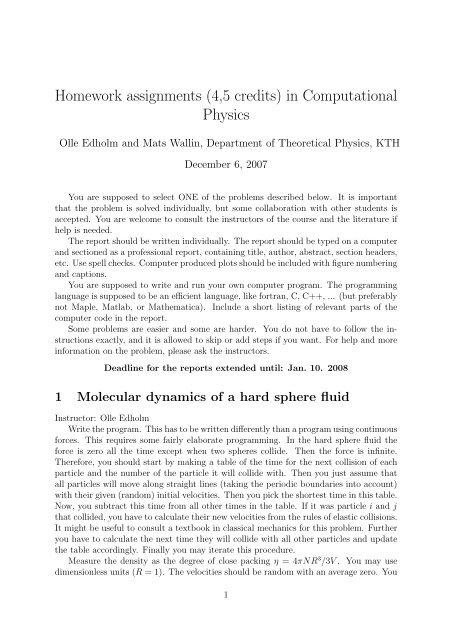
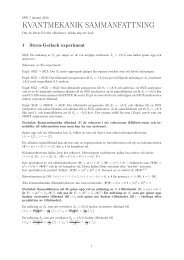

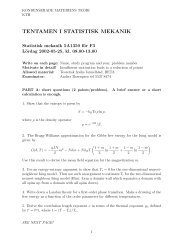
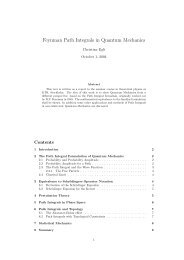
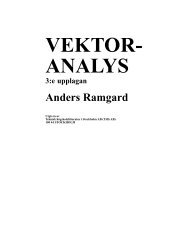
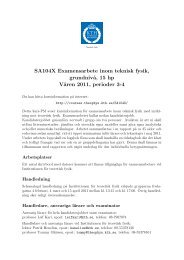

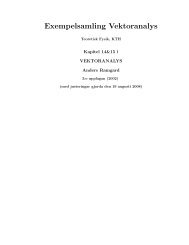

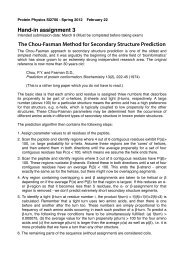

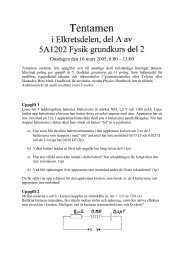
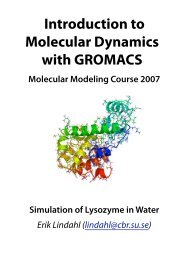
![[VAR]=Notes on variational calculus](https://img.yumpu.com/35639168/1/190x245/varnotes-on-variational-calculus.jpg?quality=85)